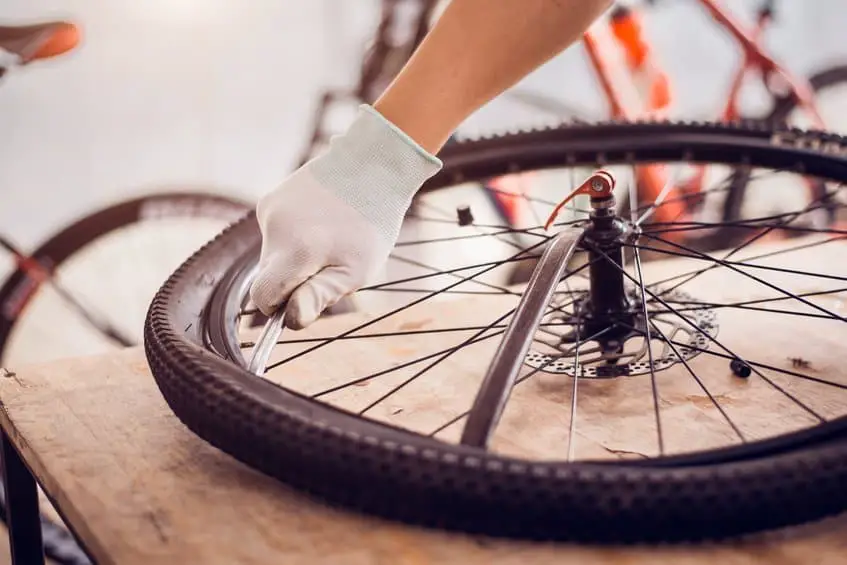Last Updated on November 21, 2022
Mountain biking is a fun sport. You get to enjoy the great outdoors, breathe fresh air, and bask in the scenic views that Mother Nature has to offer.
Many say that riding on the trails is more fun compared to cycling on paved roads. Well, that’s the truth for many because you don’t have to be very particular about many things such as weight, BMI, distance covered, or even body hair.
It might sound too much for some, but that’s a fact of road cycling! What’s more, is that aerodynamics plays a huge role in road biking.
But is becoming as aerodynamic as possible only limited for roadies?
Not really. In fact, mountain bikers should also consider this factor if they want to make the most out of the sport.
Aerodynamics and friction aren’t as much of a big deal in mountain biking compared to road cycling. But it still plays a part in the overall safety and enjoyment of the rider.
So, how is friction harmful when riding a bike?
Rough trails
Friction makes pedaling harder on mountain biking depending on the terrain you are riding on. An example would be riding your bike on uneven surfaces that include different kinds of jagged and rough rocks.
There is also a huge chance that there are covered roots that you have to tackle for you to pass safely and at the right speed. Going through rough trails is harder because of the higher friction levels, compared to road cycling where you just ride on flat and smooth pavement.
Friction plays a bigger role in cross-country mountain biking because there are more uphills. Pedaling your way upward becomes harder because of gravity. But the difficulty is much higher compared to just cycling on paved roads.
In mountain biking, you have to ride through loose rocks which lowers traction and makes it harder to climb. You also need to be fit enough so you can easily climb up hills with your lean body weight.
Weather conditions
Weather plays a huge role in your mountain biking experience. This is also where aerodynamics and friction come to play.
Biking in windy weather makes it harder for you because you need to exert more effort pedaling your way. This is especially true if it’s windy and the wind is going against your direction.
You have to pedal harder against the wind force. The wind will just slow you down. Riding in the rain also poses safety hazards because the ground is wet and slippery.
You may have lower friction levels if you ride on paved roads during the rain because the water will allow the wheels to turn faster and easier because of the wet surface. But that also puts up more risk for you because you’re more likely to slip.
Air resistance
Friction not only happens because of the terrain and weather condition but also with your bicycle and pedaling style.
Your bike’s frame and geometry play a huge role in this because the sleeker and smoother the edges of your bike are, the less friction you get, and the easier you can pedal. However, this isn’t much of a big factor compared to road bikes.
In mountain biking, there are other factors that can affect your speed and effort. Examples of these are terrain, technical skills, and adrenaline rush.
Also, note that you get more resistance if your bike moves faster. You can, however, lower down air resistance by moving to a crouching position and maintaining an aggressive riding position stance while riding.
This streamlines airflow movement and minimizes the effort you need to exert to travel further and easier than ever before.
Mountain bike tires

Mountain bike tires are another part to reckon with when it comes to friction. Your tires also need to get enough attention for you to ensure that you get as little friction as you can.
Make sure that your tires are inflated properly. If you want to go faster and have a more efficient pedaling, then it’s best you go for high PSI. Cross-country mountain biking has an average PSI of 40 to 50.
Meanwhile, enduro riding has an ideal range of 25 to 35 PSI. Downhill mountain biking, on the other hand, requires less to create a gripper hold on rough trails.
You can go for 20 to 30 tire pressure for downhill bikes. But remember that you are going to absorb more frictional force from your tires because they grip the ground and conform to the natural shape of the obstacles you’re going for.
You also need to get road-specific tires if you are going to ride your bike on paved roads. This lowers down friction force and makes you go faster because of the smooth tread pattern.
Meanwhile, enduro, trail, and downhill tires have aggressive tread patterns that are great when it comes to grip but creates high frictional forces levels. There are even some electric bikes and fat bikes that have chain wheels to increase the frictional force and rolling resistance.
Also, make sure that your wheel bearings are greased properly to increase rolling speeds and help reduce friction. You can also reduce friction by lubricating your chains.
Bike seats
Friction can undoubtedly affect your mountain bike parts, as well as your muscles, legs, and breathing, it can also affect your seat.
Many people don’t think that the saddle has a huge effect on friction. But it really can affect your ride in many ways! Friction force acts as a huge factor between your rear end and your bike saddle can have a negative effect on your ride.
Not only will this cause back pain and inflammation, but it can also lead to muscle spasms and cramps. There are even cases where riders get sores due to prolonged sitting on saddles that aren’t very aerodynamic.
We recommend you choose a bike saddle that is narrow and has a sleek low-profile design shape. This ensures that airflow and air resistance can easily flow across you and you are less likely to have sores and muscle spasms.
Is aerodynamics important in mountain biking?
No, not really. Although aerodynamics still plays a factor in mountain biking, the effects it has on the riding experience aren’t that big compared to road cycling.
Road cycling is more on covering long distances and spending hours pedaling across smooth concrete and asphalt pavements. That is where aerodynamics plays a huge part.
It’s all about maintaining high speeds and you can only do that by going as smooth as possible along with airflow. This is why roadies need to be as aerodynamic as possible when riding.
They wear lycra or the spandex cycling wear to make sure that they get lower friction levels because air can smoothly glide over the smooth-surfaced texture of lycra.
Compare that to mountain biking clothes which are quick-drying loose jerseys and baggy shorts, and you can easily see that it’s not that aerodynamic?
Why? Well, because mountain biking needs more safety in case you fall, crash, or slip off your bike. Lycra wouldn’t help protect your skin from scratches because it’s very thin. It’ll just be scratched and torn up.
Also, mountain biking is more about being able to traverse technical terrain. You don’t just need to have lots of endurance, but you also need to know how to bring your bike along with your body on seemingly impassable trails so that you’ll also know-how is friction harmful when riding a bike.
Conclusion
Friction poses many disadvantages in mountain biking. Fortunately, there are many ways to avoid these and lower down friction levels. Simply follow the tips we’ve mentioned in this article, and you’ll surely have a better experience riding your mountain biking in the outdoors.
